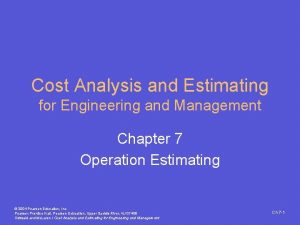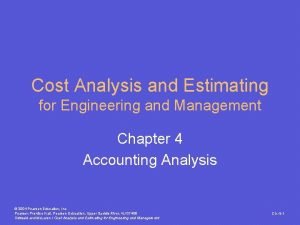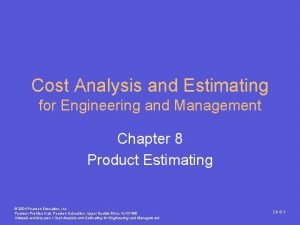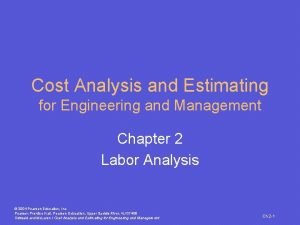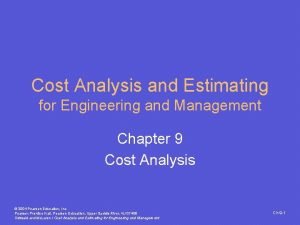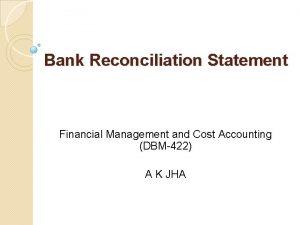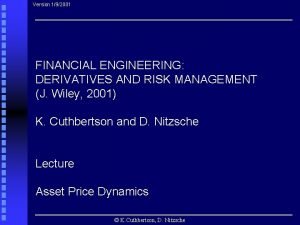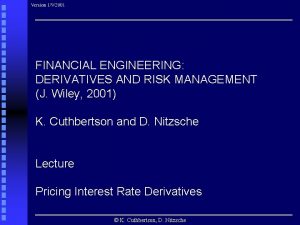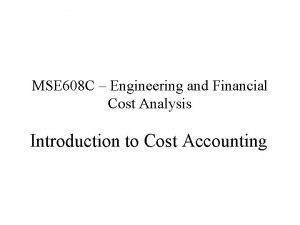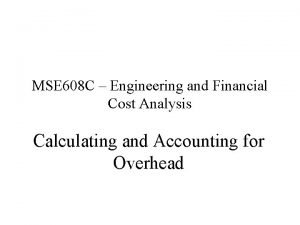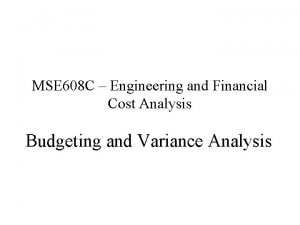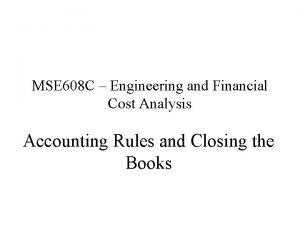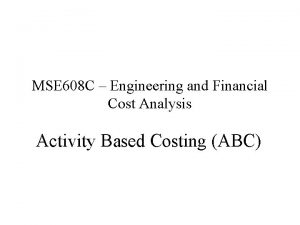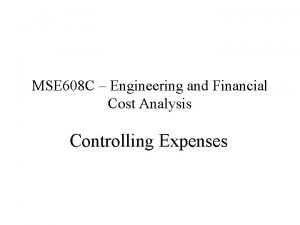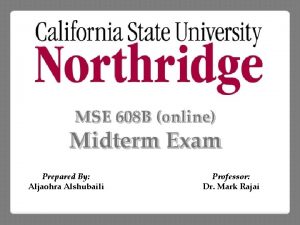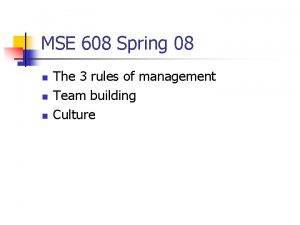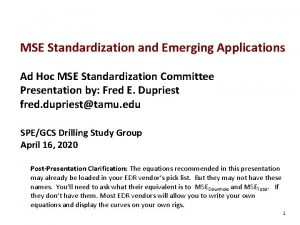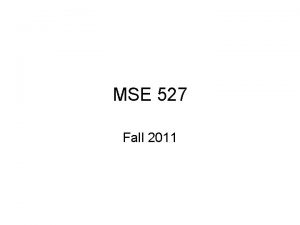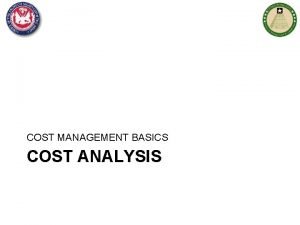MSE 608 C Engineering and Financial Cost Analysis




























- Slides: 28

MSE 608 C – Engineering and Financial Cost Analysis Financial Ratios and Analysis

Analyzing Financial Statements • Balance Sheet – The financial condition of the company on a certain date (a snapshot on that date) • Income Statement – The financial performance of the company over a period of time (the accounting period) • Cash Flow Statement – Sources and Uses of Cash over the accounting period • Financial Ratios – Compares financial data to create insightful relationships about the company’s financial health and operating performance.

Types of Financial Ratios • Liquidity Measures a firms ability to meet it near-term obligations. • Working capital or Efficiency Indication of how well a firm is using it’s assets to generate profits. • Capital Structure or Solvency Provide indications on how a firms is financing it’s investment in assets. • Profitability or Operating Used to measure if a company is generating sufficient returns on it’s investments. • Investment or Market Test Measures used by many investors to compare a company’s earnings and dividend payments to it’s stock price.

Liquidity Ratios Liquidity measures the financial strength of an organization and it’s ability to pay it’s debts. • Liquidity The measure of a company’s ability to meet current obligations when they are due. Current obligations are all current expenses • Salaries Payable; Accounts Payable; and Rent Payable The two common Liquidity Ratios: • Current ratio; • Quick, or Acid Test

Liquidity Ratios • Current Ratio = Current Assets Current Liabilities – Current Assets include cash; marketable securities; accounts receivable; inventory; and prepaid expenses. • Quick Ratio = Quick Assets Current Liabilities – Uses only the most liquid assets; cash, marketable securities and accounts receivable.

Questions? ? • How can a company manipulate it’s Liquidity ratios? • What would happen if a company changed from FIFO to LIFO to account for Inventory valuation? • Where would clues be found to indicate the Liquidity ratio was manipulated?

Working Capital Ratios Measures how effectively a company utilizes it’s Working Capital to generate profits • Inventory – Inventory turnover • Accounts Receivable – Accounts Receivable Turnover – Average Collection Period • Accounts Payable – Accounts payable payment period • Assets – Fixed Asset Turnover – Total Asset Turnover

Inventory • Inventory Turnover = COGS Average Inventory • This tells how many times the inventory turned-over during the accounting period. The more times the inventory is turned, or used, the more efficient the company. – Inventory is expensive to purchase and hold. – Faster turnover means less risk of obsolescence. – On the other hand, the company must avoid stockouts and lost business.

Accounts Receivable • Accounts Receivable Turnover = Annual Credit Sales Average Accounts Receivables – Indicator of how well credit sales are collected. The more times Accounts Receivable is turned over, the more efficient the company and more working capital is available. • Average Collection Period = Average Accounts Receivables (Annual Credit Sales ¸ 365) – Calculates the average number of days it takes to collect payments due. – Can indicate a problem if higher than the credit terms that are offered. – A low number may indicate a company is only selling to customers who pay quickly. There may be untapped opportunities for new customers.

Accounts Payable • Accounts Payable Payment Period = Average Accounts Payable (Annual Credit Purchase¸ 365) – The amount of credit purchases is not usually available in financial statements; use Cost-of-Goods-Sold or other figure as a replacement. – Identifies the average number of days from receipt of goods or services until they are paid. – The longer the Period the more working capital is held and available to the company. – This is non-interest borrowing except for the loss of Prompt Payment Discounts.

Assets • Fixed Asset Turnover = Sales Revenue Average Fixed Assets • Total Asset Turnover = Sales Revenue Average Total Assets – These ratios indicate how effectively a company is utilizing it’s assets, both current assets and non-current assets to generate Revenues.

Questions ? ? ? • If the Accounts Receivable Collection period changed from 36 days to 48 days what would this indicated? • What is the impact if the Inventory Turnover rate goes from 7. 3 times to 6. 2?

Capital Structure Ratios Provide indications on how a firms is financing it’s investments in assets. • Total Debt – Total Debt to Owners’ Equity – Total Debt to Total Assets • Long-term Debt – Long-term Debt to Total Capitalization • Interest Expense – Times Interest Earned • Debt Financing: requires repayment of the principle and interest. • Equity Financing: No obligation to repay and no interest.

Total Debt • Total Debt to Owners’ Equity = Total Debt Owners’ Equity – Total Debt = Current liabilities + non-current liabilities – Measures the relationship between borrowed funds and equity financing – A company with a higher percentage than similar companies may use too much borrowing compared to owner financing. • Total Debt to Total Assets = Total Debt Total Assets – Measures the extent to which total asset are financed by borrowed funds (as opposed to owners equity) – A company with a higher percentage than similar companies may have problems borrowing more money.

Long-term Debt • Long-term Debt to Total Capitalization = Non-current liabilities Total Capitalization – Total Capitalization = Long-term Debt + Owners’ Equity – It measures the percentage of Long-term debt to all permanently invested capital from all sources. – Some analyst include deferred taxes in total capitalization since it may essentially be a permanent investment in the company. • The ratio will vary by business and industry. – A small corporation may have a high ratio due to a high level of borrowed funds and a low amount of equity financing. – A larger, publicly traded corporation will have a lower ratio due to a high level of equity financing.

Interest Expense Times Interest Earned Ratio = Earnings Before Interest and Taxes (EBIT) Interest Expense –EBIT is found on the Income Statement as the net Operating Profit before subtracting interest expense and taxes. –Measures the ratio of the Operating Profit available to service debt. –The higher the number the greater the safety margin and the lower the risk a company can pay it’s debts.

Questions ? ? ? • A high Total Debt to Owners Equity ratio could have what implications? • How could this be corrected?

Profitability Ratios Used to measure if a company is generating sufficient returns on it’s investments. • Sales – Gross Profit Margin – Operating Profit Margin – Net Profit Margin • Equity – Return on Equity (ROE) • Assets – Return on Assets (ROA)

Sales • Gross Profit Margin – – – Gross Profit Margin = Gross Profit Net Sales Revenue Gross Profit = Nets Sales - COGS Net Sales Revenue = Sales Revenues - returns. Represents the markup on Cost of Goods Sold Represents the amount of net sales that will cover operating expenses, interest and taxes. A common measure used by engineering and sales managers. New products or services must almost always meet a minimum Gross Profit Margin before it is offered.

Sales Operating Profit Margin = Net operating income Net Sales Revenue – Used as a measure of operating efficiency in relation to sales revenues. • Net Profit Margin = Net Income Net Sales Revenue – Measures the relationship of net profit to sales revenues. – Will show many cents on each sales revenue dollar becomes profit.

Equity and Assets • Return on Equity (ROE) Return on Equity = Net Income Average Owners’ Equity – Measures the percentage of owners’ equity that becomes profit. – Measures a company’s return on owner financing. • Return on Assets (ROA) Return on Equity = ______EBIT____ Average Total Assets – Measure a company’s return on it’s investment in total assets. – Use EBIT to account for Interest (a function of Capital Investment)

Questions ? ? ? • A high Gross Profit Margin always means a high Net Profit Margin? • What types of Industries would require a high Gross Profit Margin? • Why do some analyst look primarily at a company’s Operating Profit Margin rather than the Net Profit Margin?

Investment/Market Test Ratios • Measures used by many investors to compare a company’s earnings and dividend payments to stock prices. – Earnings per Share – Price to Earnings – Dividend Yield

Investment/Market Test Ratios • Earnings per Share (EPS) EPS = Net Income Average number of shares of common stock – Calculating the number of shares of common stock is complicated by stock options, warrants and convertible securities. • Price to Earnings (P/E) P/E = Average. Market Price per Share Earnings per Share – Indicates how many time Earnings investors are willing to pay for shares. • Dividend Yield = Dividends per Share Market Price per Share – The percent yield in dividends per dollar paid for a share of stock.

Analyzing the Results Ratio analysis is a tool that can provide insights into a company’s performance not readily available on the financial statements. • Compare to benchmarks – Historical benchmarks (trends) – External benchmarks

Analyzing Financial Statements • Financial Information – Balance Sheet – Income Statement – Cash Flow Statement – Financial Ratios • Trends • Industry Norms • Industry/Competitive Analysis


Assessment • What are the five (5) categories of financial ratios? • Generally, what does each group tell you about a company? • What do the Investment ratios tell you about the performance of a company? • What are the two benchmarks used for comparision?
 Army bah regulation 608 99
Army bah regulation 608 99 Process mining
Process mining Lei nº12.608/12
Lei nº12.608/12 Mse total cost
Mse total cost Cost analysis and estimating for engineering and management
Cost analysis and estimating for engineering and management Cost analysis and estimating for engineering and management
Cost analysis and estimating for engineering and management Cost analysis and estimating for engineering and management
Cost analysis and estimating for engineering and management Cost analysis and estimating for engineering and management
Cost analysis and estimating for engineering and management Cost analysis and estimating for engineering and management
Cost analysis and estimating for engineering and management Cost behavior patterns
Cost behavior patterns Analisis dan estimasi biaya
Analisis dan estimasi biaya Cost accumulation and cost assignment
Cost accumulation and cost assignment Cost accumulation and cost assignment
Cost accumulation and cost assignment Cost pools
Cost pools What is a period cost on the income statement
What is a period cost on the income statement Cost control and cost reduction difference
Cost control and cost reduction difference Characteristics of standard costing
Characteristics of standard costing Distinguish between average cost and marginal cost
Distinguish between average cost and marginal cost Cost control and cost reduction difference
Cost control and cost reduction difference Job order cost system
Job order cost system Ordering cost and carrying cost
Ordering cost and carrying cost Trade offs and opportunity cost
Trade offs and opportunity cost Cost control and cost reduction project report
Cost control and cost reduction project report Cost control and cost reduction project report
Cost control and cost reduction project report Cost accounting reconciliation statement
Cost accounting reconciliation statement Examples of non financial methods of motivation
Examples of non financial methods of motivation Financial engineering derivatives and risk management
Financial engineering derivatives and risk management Febadvisor
Febadvisor Financial engineering derivatives and risk management
Financial engineering derivatives and risk management




